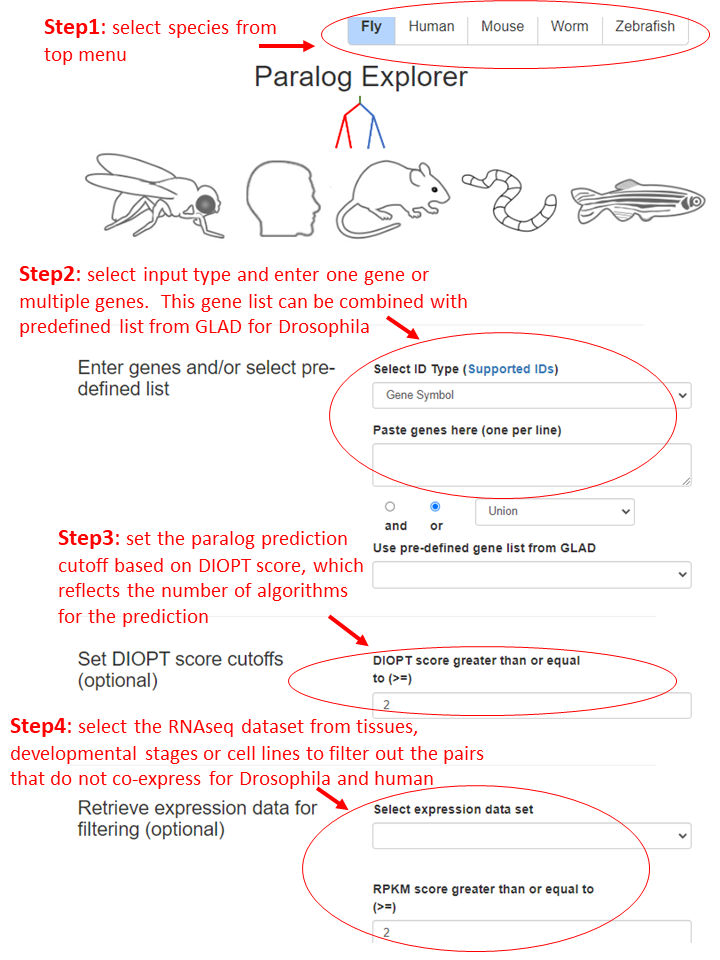Introduction
Paralog gene pairs for Drosophila, Human, Mouse, Zebrafish and Worm were extracted from DIOPT vs8 with DIOPT score > 1. This tool allows user to find that within the input gene list (either customized gene list from user or predefined Drosophila gene list from GLAD), which genes have paralogs and the basic information about each genes of each paralog pair. This tool allows user to retrieve the expression data that is selected so that the paralog list can be sorted or filtered based on expression level of specific tissue, cell line or developmental stage. This tool also allows user to retrieve and compare the genetic/protein-protein interaction data for each paralog pair.
Instruction
- Step1. Choose the species of the input genes from top menu
- Step2. Select the input type. Either official gene symbol, Entrez GeneID or species-specific gene identifier (eg. FlyBase GeneID) are supported. The information about the species-specific gene identifiers can be found at https://www.flyrnai.org/tools/paralogs/web/species. Then enter gene, genes or choose a predefined gene list from GLAD for Drosophila.
- Step3. Select the cutoff of DIOPT paralog prediction score. DIOPT is an integrative tool of ortholog/paralog prediction and the score reflects the agreement of the prediction among various algorithms. For example, a score of 4 means that 4 different algorithms predict such paralog relationship while a score of 2 means that only 2 algorithms predict such paralog relationship.
- Step4. Filter based on expression data
Select one of the expression datasets as filter to filter out gene pairs that either one or both do not express based on selected dataset. GTEx (https://www.gtexportal.org/) tissue RNA-seq as well as CCLE (https://sites.broadinstitute.org/ccle/ ) cell line RNA-seq datasets are available for human genes while modEncode (http://www.modencode.org/) tissue, developmental stage and cell line datasets are available for Drosophila genes.

About the result table
The result is displayed in a table format including the prediction score, protein alignment (length, identity and similarity), genome location, gene ontology annotation of each gene as well as common annotation shared by both genes, genetic and PPI partners, the common interaction partners shared by both genes. The columns can be customized as well as exported by the user. For Drosophila and human genes, the correlation analysis of expression is available and is visualized by bar graph.
About the algorithms
| DIOPT algorithms | Relevant for Paralog Explorer |
| Compara | Yes |
| eggNOG | Yes |
| HGNC | No |
| Hieranoid | No |
| Homologene | Yes |
| Inparanoid | Yes |
| Isobase | Yes |
| OMA | No |
| OrthoDB | Yes |
| OrthoFinder | Yes |
| OrthoInspector | No |
| orthoMCL | Yes |
| Panther | Yes |
| Phylome | No |
| RoundUp | Yes |
| TreeFam | No |
| ZFIN | No |
Publications
Ewen-Campen B, Mohr SE, Hu Y, Perrimon N. Accessing the Phenotype Gap: Enabling Systematic Investigation of Paralog Functional Complexity with CRISPR. Dev Cell. 2017 Oct 9;43(1):6-9. doi: 10.1016/j.devcel.2017.09.020. Review. PMID: 29017030. https://www.ncbi.nlm.nih.gov/pubmed/29017030
Yanhui Hu, Ben Ewen-Campen, Aram Comjean, Jonathan Rodiger, Stephanie E. Mohr, Norbert Perrimon. Paralog Explorer: a resource for mining information about paralogs in common research organisms doi: https://doi.org/10.1101/2022.07.22.501126 https://www.biorxiv.org/content/10.1101/2022.07.22.501126v1 https://www.biorxiv.org/content/10.1101/2022.07.22.501126v1